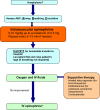Anaphylaxis
- PMID: 30263034
- PMCID: PMC6156836
- DOI: 10.1186/s13223-018-0283-4
Anaphylaxis
Abstract
Anaphylaxis is an acute, potentially fatal systemic allergic reaction with varied mechanisms and clinical presentations. Although prompt recognition and treatment of anaphylaxis are imperative, both patients and healthcare professionals often fail to recognize and diagnose early signs and symptoms of the condition. Clinical manifestations vary widely; however, the most common signs are cutaneous symptoms, including urticaria, angioedema, erythema and pruritus. Immediate intramuscular administration of epinephrine into the anterolateral thigh is first-line therapy, even if the diagnosis is uncertain. The mainstays of long-term management include specialist assessment, avoidance measures, and the provision of an epinephrine auto-injector and an individualized anaphylaxis action plan. This article provides an overview of the causes, clinical features, diagnosis and acute and long-term management of this serious allergic reaction.
Keywords: Acute management; Anaphylaxis; Anaphylaxis action plan; Diagnosis; Epinephrine; Long-term management.
Figures
References
-
- Lieberman P, Nicklas RA, Randolph C, Oppenheimer J, Bernstein D, Bernstein J, Ellis A, Golden DB, Greenberger P, Kemp S, Khan D, Ledford D, Lieberman J, Metcalfe D, Nowak-Wegrzyn A, Sicherer S, Wallace D, Blessing-Moore J, Lang D, Portnoy JM, Schuller D, Spector S, Tilles SA. Anaphylaxis—a practice parameter update 2015. Ann Allergy Asthma Immunol. 2015;115(5):341–384. doi: 10.1016/j.anai.2015.07.019. - DOI - PubMed
Publication types
LinkOut - more resources
Full Text Sources
Other Literature Sources


